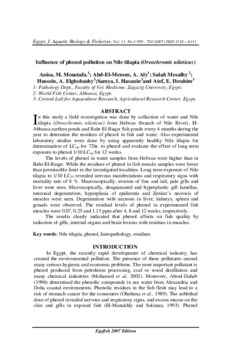Influence of phenol pollution on Nile tilapia (Oreochromis niloticus)

Citation
Moustafa, A.M. et al. (2007). Influence of phenol pollution on Nile tilapia (Oreochromis niloticus). Egyptian journal of aquatic biology and fisheries 11(3):709-720
In this study a field investigation was done by collection of water and Nile tilapia (Oreochromis niloticus) from Helwan (branch of Nile River), El- Abbassa earthen ponds and Bahr El-Baqar fish ponds every 4 months during the year to determine the residues of phenol in fish and water. Also experimental laboratory studies were done by using apparently healthy Nile tilapia for determination of LC50 for 72hr. to phenol and evaluate the effect of long term exposure to phenol 1/10 LC50 for 12 weeks. The levels of phenol in water samples from Helwan were higher than in Bahr-El-Baqar. While the residues of phenol in fish muscle samples were lower than permissible limit in the investigated localities. Long term exposure of Nile tilapia to 1/10 LC50 revealed nervous manifestations and respiratory signs with mortality rate of 8 %. Macroscopically, erosion of fins and tail, pale gills and liver were seen. Microscopically, desquamated and hyperplastic gill lamellae, neuronal degeneration, hyperplasia of epidermis and Zenker’s necrosis of muscles were seen. Degeneration with necrosis in liver, kidneys, spleen and gonads were observed. The residual levels of phenol in experimented fish muscles were 0.07, 0.25 and 1.15 ppm after 4, 8 and 12 weeks, respectively. The results clearly indicated that phenol affects on fish quality by induction of gills, internal organs and brain lesions with residues in muscles.
Permalink
Date Available
Type
ISSN
1110-6131
Research Themes
Topics
Language